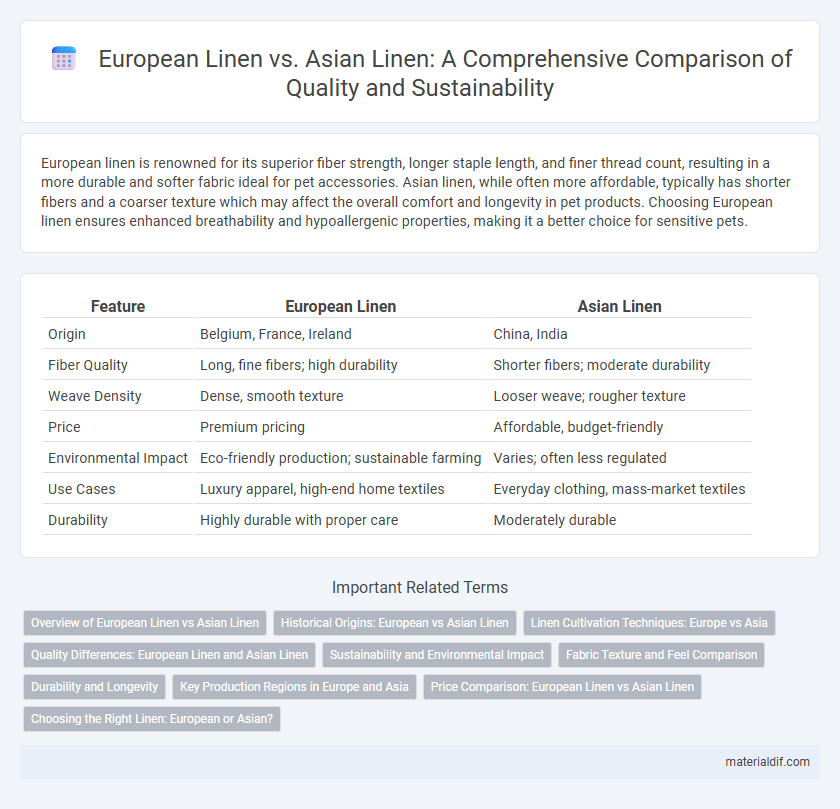European linen is renowned for its superior fiber strength, longer staple length, and finer thread count, resulting in a more durable and softer fabric ideal for pet accessories. Asian linen, while often more affordable, typically has shorter fibers and a coarser texture which may affect the overall comfort and longevity in pet products. Choosing European linen ensures enhanced breathability and hypoallergenic properties, making it a better choice for sensitive pets.
Table of Comparison
| Feature | European Linen | Asian Linen |
|---|---|---|
| Origin | Belgium, France, Ireland | China, India |
| Fiber Quality | Long, fine fibers; high durability | Shorter fibers; moderate durability |
| Weave Density | Dense, smooth texture | Looser weave; rougher texture |
| Price | Premium pricing | Affordable, budget-friendly |
| Environmental Impact | Eco-friendly production; sustainable farming | Varies; often less regulated |
| Use Cases | Luxury apparel, high-end home textiles | Everyday clothing, mass-market textiles |
| Durability | Highly durable with proper care | Moderately durable |
Overview of European Linen vs Asian Linen
European linen is renowned for its high-quality fibers grown in Belgium, France, and Ireland, offering superior strength and a smooth, lustrous finish. Asian linen, primarily sourced from China and India, tends to be more affordable but varies in texture and durability due to different harvesting and processing methods. The climate and soil conditions in Europe contribute to longer flax fibers, resulting in more durable and premium linen products compared to Asian linen.
Historical Origins: European vs Asian Linen
European linen traces its origins to ancient flax cultivation in the Mediterranean and Northern Europe, where cooler climates favored fine, high-quality fiber production. Asian linen, particularly from China and India, boasts a rich history intertwined with early silk and cotton trade routes, utilizing local flax varieties adapted to warmer climates. These distinct historical origins influence the texture, strength, and weaving techniques characteristic of European and Asian linen fabrics.
Linen Cultivation Techniques: Europe vs Asia
European linen cultivation utilizes long-stem flax varieties grown in cooler, temperate climates, resulting in fibers known for their strength and fine quality. In contrast, Asian linen, particularly from China and India, is often produced using shorter-stem flax or ramie plants cultivated in warmer, humid environments, which can impact fiber length and texture. The European retting process typically involves dew retting, promoting a softer, more pliable fiber, whereas Asian methods frequently employ water retting, affecting fiber color and durability.
Quality Differences: European Linen and Asian Linen
European linen is renowned for its superior fiber strength and longer staple length, resulting in finer, more durable fabric with a smoother texture. Asian linen, while often more affordable, typically has shorter fibers and may contain more impurities, affecting its overall softness and longevity. The careful harvesting and processing techniques in Europe ensure higher quality linen that excels in breathability and resilience.
Sustainability and Environmental Impact
European linen exhibits higher sustainability due to stringent environmental regulations and organic farming practices that minimize pesticide use and water consumption. Asian linen, while often more cost-effective, may involve intensive chemical treatments and less rigorous ecological standards, leading to a larger environmental footprint. Choosing European linen supports reduced greenhouse gas emissions and promotes soil health through crop rotation and sustainable land management.
Fabric Texture and Feel Comparison
European linen is renowned for its superior fabric texture, offering a smoother and softer feel due to the higher quality flax fibers grown in cooler climates. Asian linen, often made from flax grown in warmer regions, tends to have a coarser texture with a slightly rougher hand, making it more durable but less refined. The difference in fiber processing techniques between Europe and Asia also impacts the fabric's overall softness and drape.
Durability and Longevity
European linen, particularly from Belgium and France, is renowned for its superior durability and longer lifespan due to flax fibers grown in optimal European climates that produce stronger, finer threads. Asian linen, often sourced from countries like India and China, tends to have shorter fibers, resulting in fabrics that wear out more quickly and show signs of pilling sooner. The tightly woven European linen maintains its integrity after multiple washes, making it the preferred choice for long-lasting, high-quality linen products.
Key Production Regions in Europe and Asia
European linen production is concentrated in Belgium, France, and the Netherlands, where cool climates and rich soil yield high-quality flax fibers known for their durability and smooth texture. In Asia, key linen production regions include China and India, where warmer climates facilitate rapid flax growth but often result in coarser fibers compared to European varieties. The distinction in growing conditions and processing techniques between Europe and Asia significantly impacts the linen's strength, softness, and overall quality.
Price Comparison: European Linen vs Asian Linen
European linen typically commands higher prices due to its premium quality, environmentally sustainable production methods, and long-standing reputation for durability and softness. Asian linen, often produced at larger scales with more cost-effective labor and materials, tends to be more affordable but may offer varying quality levels. Consumers seeking luxury and longevity often prefer European linen despite its premium cost, while those prioritizing budget may consider Asian linen options.
Choosing the Right Linen: European or Asian?
European linen, renowned for its long fiber length and superior strength, offers exceptional durability and a luxurious texture ideal for high-end textiles. Asian linen, often sourced from shorter fibers, provides affordability and versatility suitable for everyday use and diverse fabric blends. Selecting the right linen depends on prioritizing quality and longevity with European options or opting for budget-friendly, accessible Asian linen alternatives.
European Linen vs Asian Linen Infographic

 materialdif.com
materialdif.com